Creatures need food, water, cover, and even places to raise their young in our cold and snowy Central New York winter, and we try to provide these habitat basics.
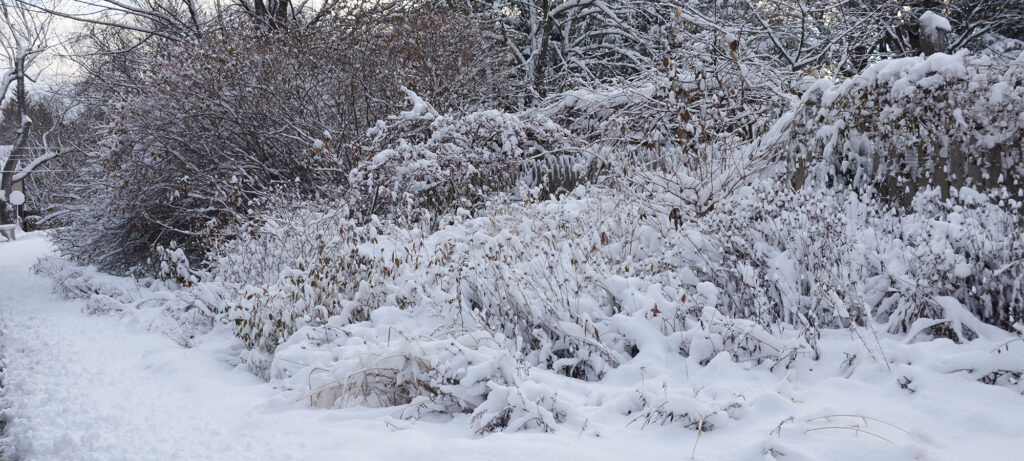
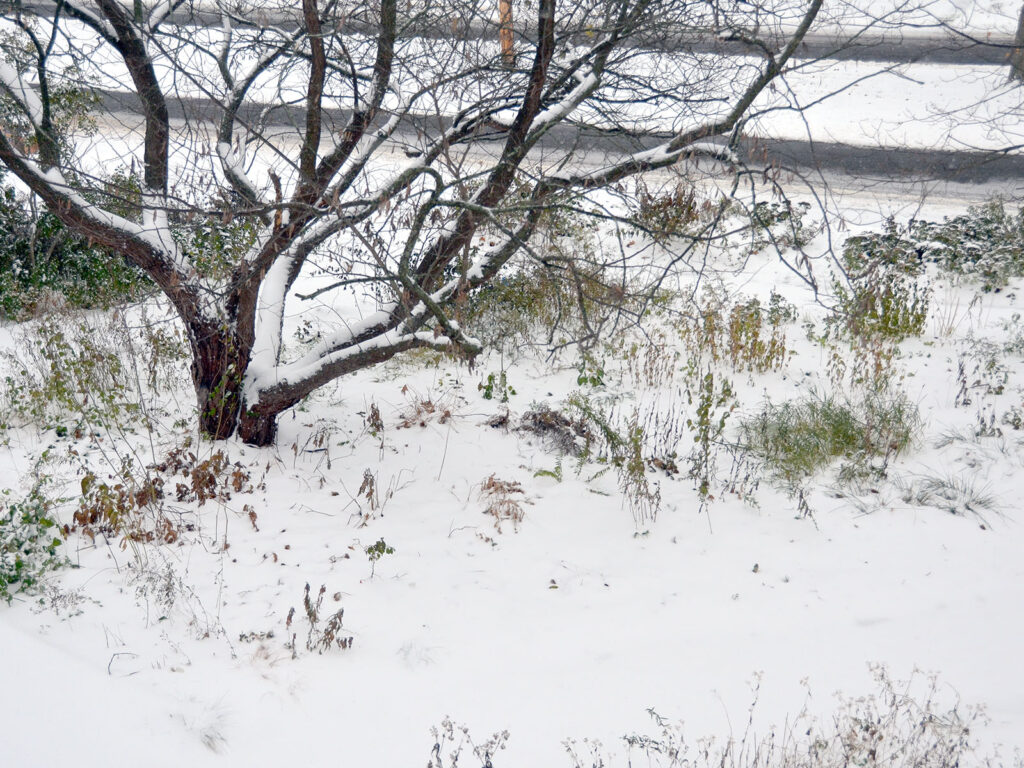
We leave the plants throughout the fall and winter so insects can overwinter there and birds can find bits of food. We think it’s much more interesting than plain old snow cover (mimicking the look of plain old lawn the rest of the year!)
Birds
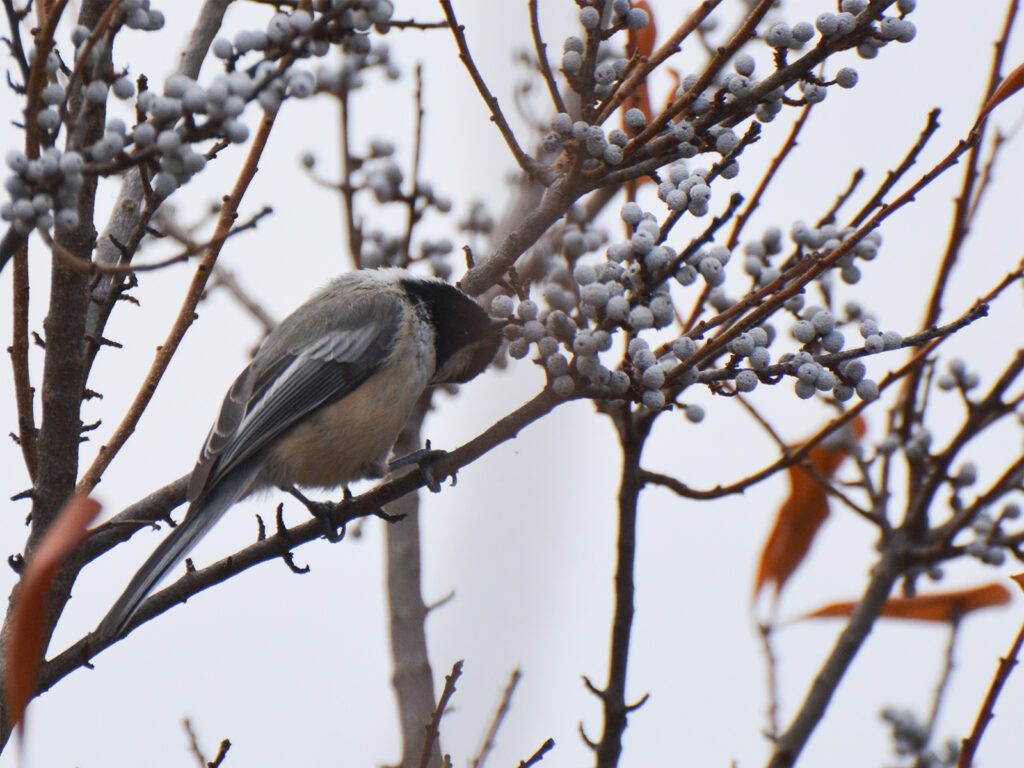
Birds keep us connected to the natural world in winter. They’re much easier to spot in winter’s leafless trees, and watching them from the comfort of our cozy family room is something we enjoy. We provide food, water, and cover for them in the winter and look forward to spring when we can provide what they need to raise their young.
Food for birds
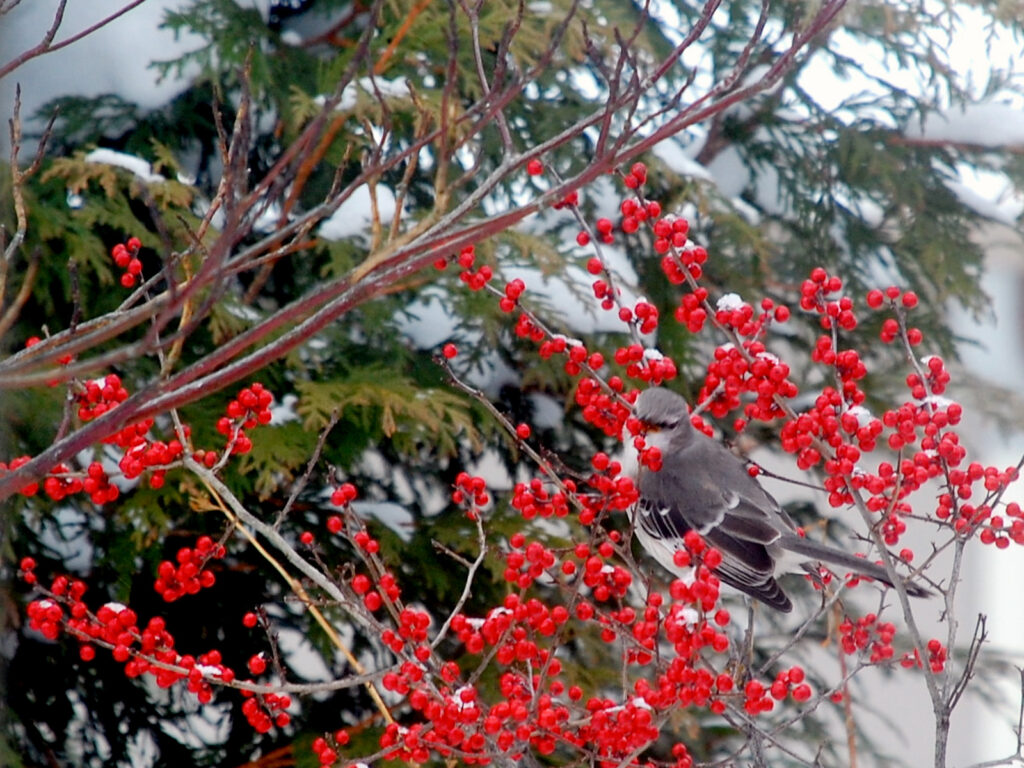
One of the more important things we’ve done is to have planted a number of bushes with berries for birds.
We’re lucky that this colorful winterberry is right outside our family room window. It’s very cheerful to see. We’ve often seen mockingbird, robins, and cardinals eating from this bush.
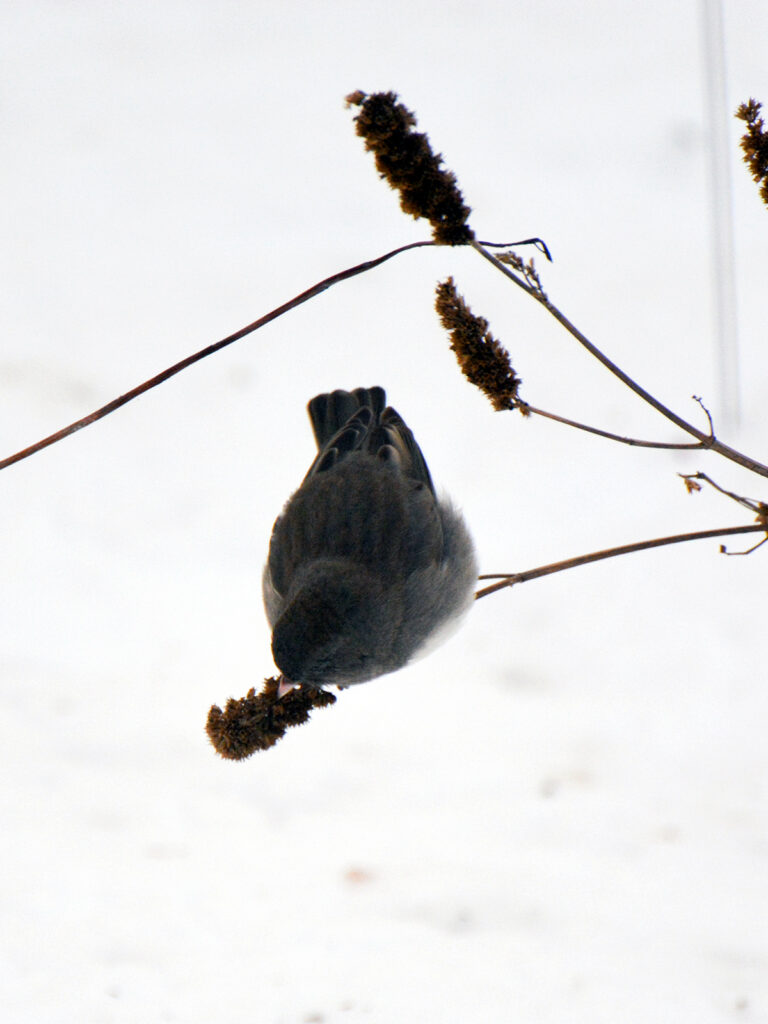
Seeds don’t have to come in a plastic bag! This junco is enjoying seeds from our native grasses. We have switchgrass, little bluestem, big bluestem, bottlebrush grass and others.
We resist the temptation to deadhead all the flowers, and we leave them most of them standing throughout the winter. We love to see the goldfinches land on them to get a meal. Having some vegetation also makes the yard much more appealing than seeing just snow everywhere.
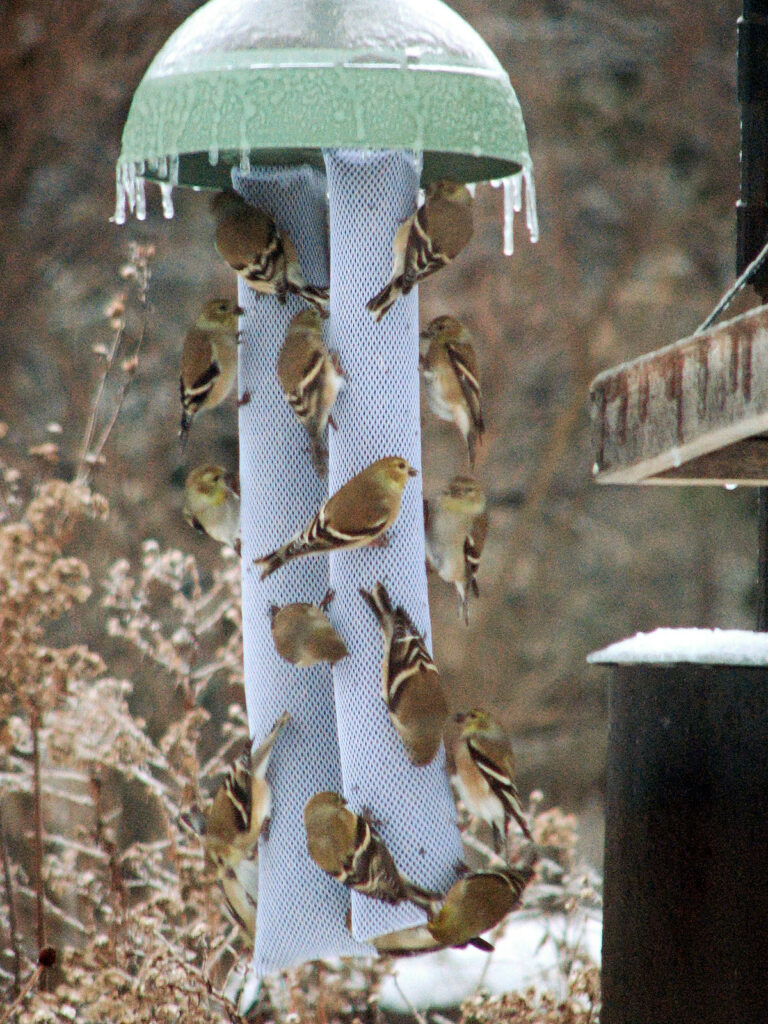
We also have bird feeders: a standard one filled with sunflower kernels (a lot less messy than whole sunflower seeds), sometimes safflower seeds, thistle feeders for the finches, and suet holders. Although there are lots of natural sources of seed for goldfinches, it’s always fun to see a flock at the nyger (thistle) feeder. I like this style of feeder. I can fill it up in the top reservoir and just take off the dirty “socks” and replace with clean socks.
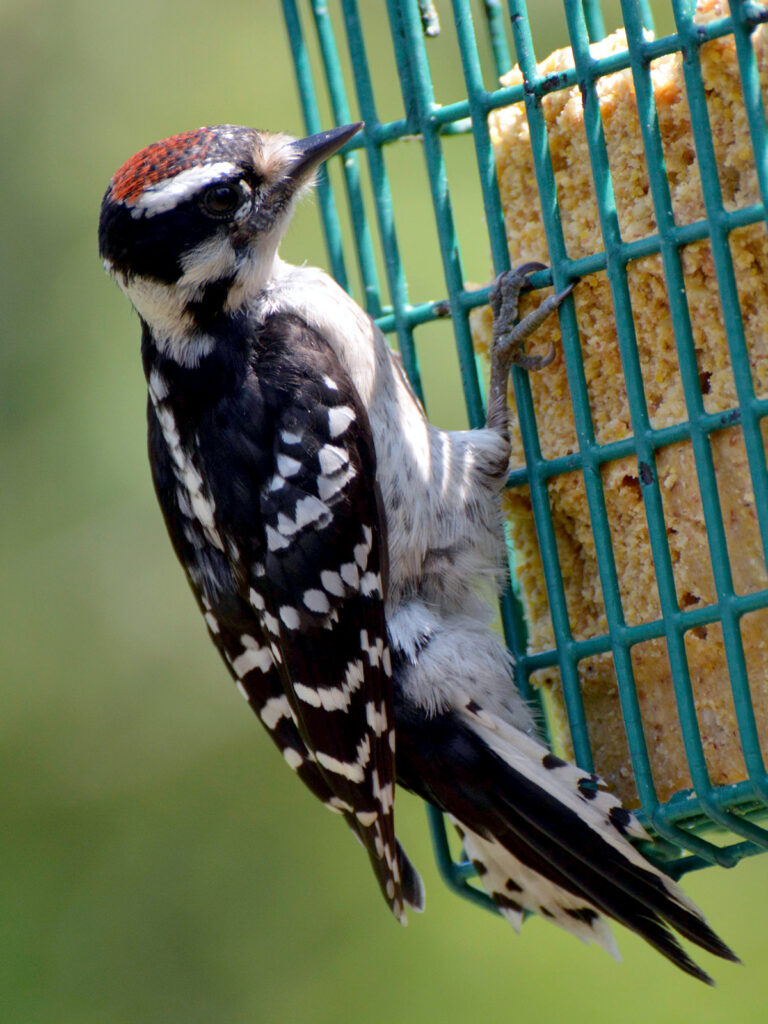
Suet provides energy in a concentrated form. We provide suet in the spring and fall, too, and sometimes summer. When it’s going to be warm, we make sure we buy the year-round suet, though that’s generally what we buy anyway.
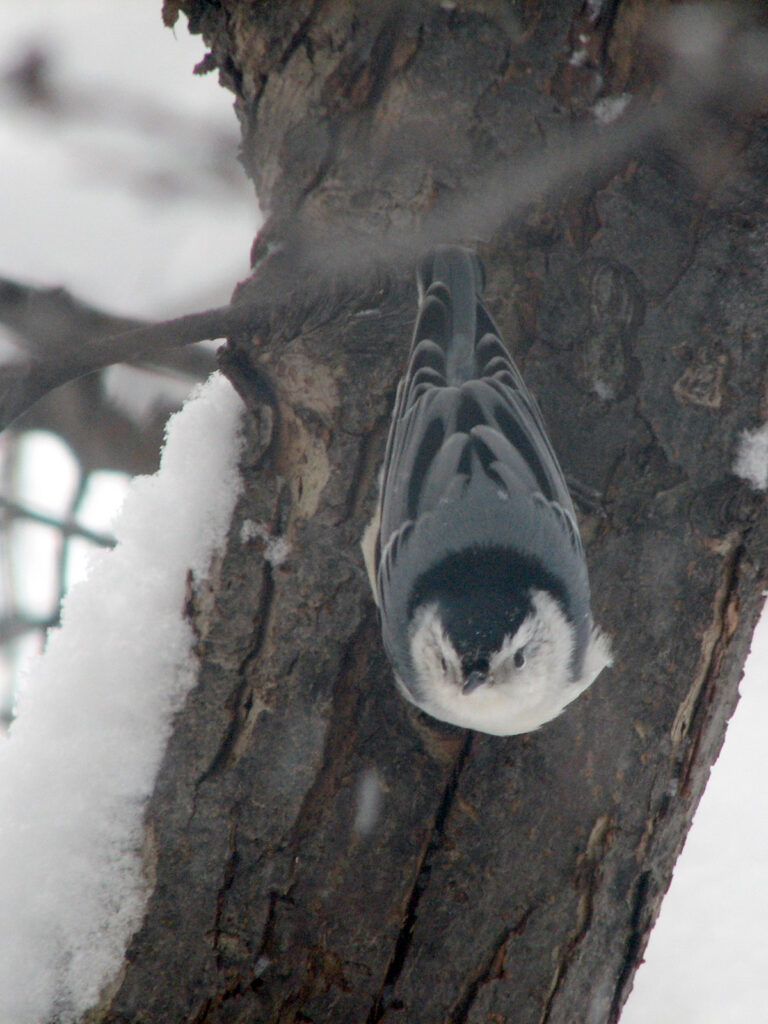
This nuthatch might be searching for little insects hiding in the bark of this dead apple tree. Nuthatches have a beautiful system: they search for insects going from the top of the tree down, so they find things other more-conventional birds going from bottom up would miss. Their feet look a bit different than other birds’ feet since they’re adapted for this special type of locomotion.
Water for birds
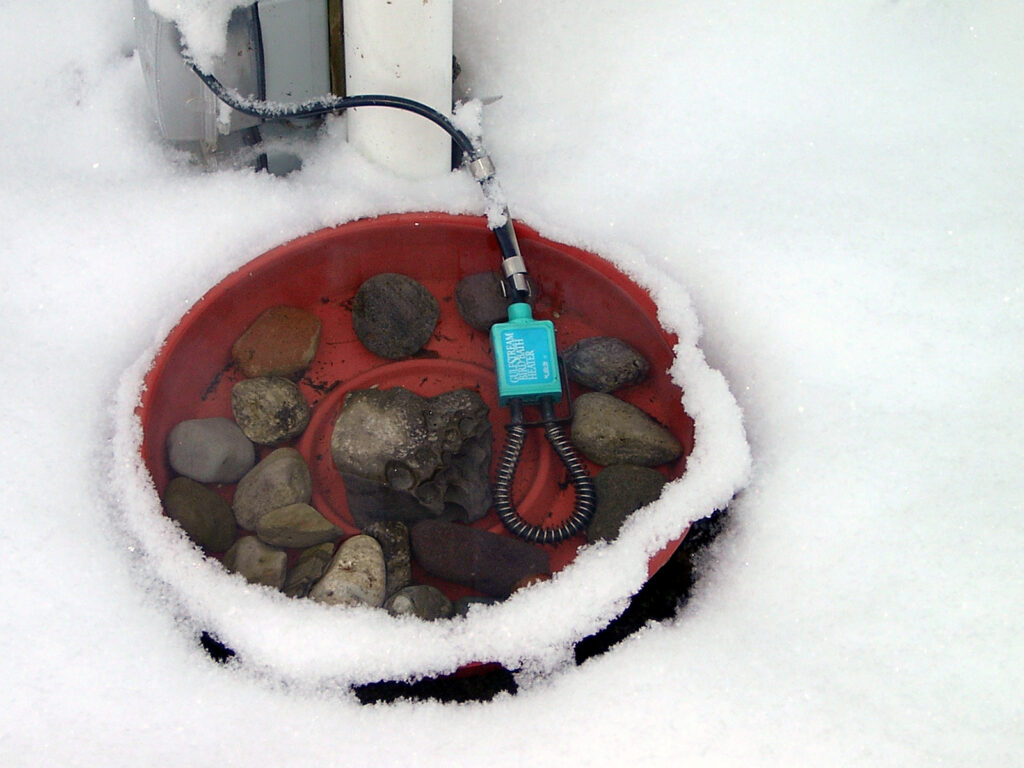
Birds need water in winter, too. How do they get it when everything’s frozen? They eat snow. Snow is not in short supply, but we also provide a heated birdbath to help them save energy. In the past, we tried a few different pond heaters, but they used way too much energy—and climate change is the biggest threat to birds. Now we use a simple heater coil designed for birdbaths. It just rests in the plastic bath and is thermostatically controlled. We plug it into the pond’s GFI outlet for safety.
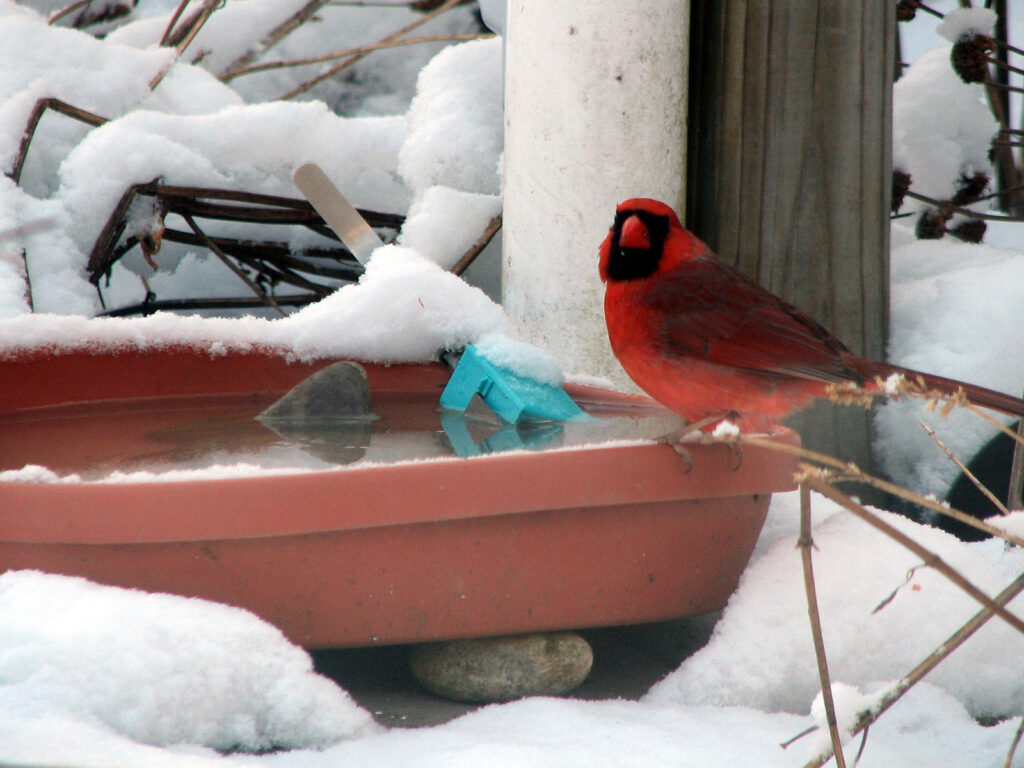
We added the rocks so that birds would have something to stand on. We also hope the stones discourage them from taking a bath in the cold weather.
Cover for birds
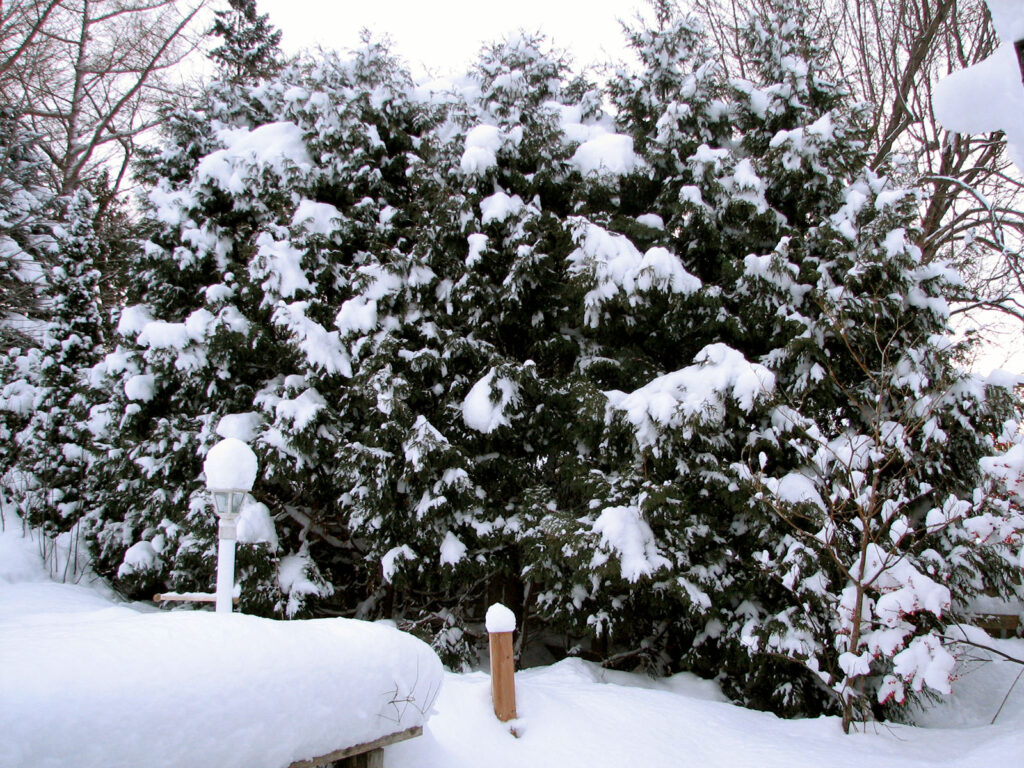
We try to provide lots of natural cover, so we’ve planted arborvitae (Thuja occidentalis), junipers (Juniperus virginiana), and hemlock (Tsuga canadensis) evergreens. They’re all well-used.
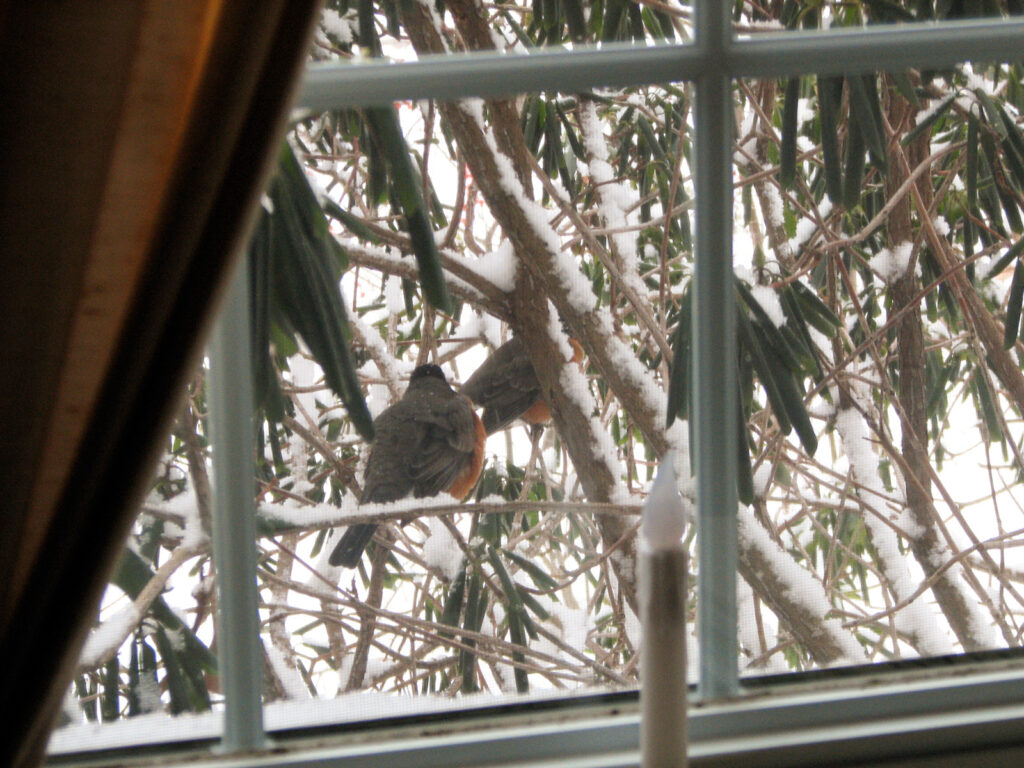
We’ve been surprised to see that many birds use our rhododendron for cover — surprised because their thin leaves don’t seem to offer as much protection as evergreens. Besides these robins, we also see cardinals, chickadees, and others.
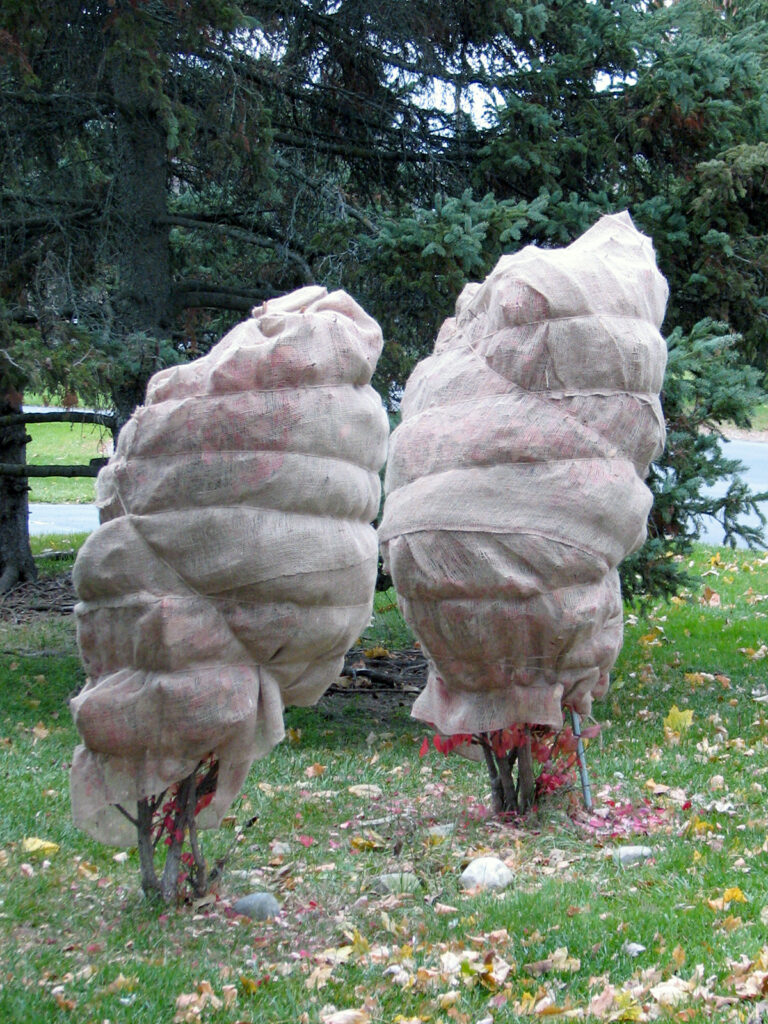
We saw this on our walk in the neighborhood.
How sad to see evergreens bundled up and not available as cover during the long winter!
We’ve left our nest boxes up over the winter, but so far it doesn’t look like they’ve been used. We also installed a tall, narrow bird house called a roost box. Its entry hole is at the bottom rather than the center and has three staggered perches inside. It’s designed so that many birds can roost together, sharing body heat. It appears they haven’t used these either, though it’s installed so high that we haven’t been able to monitor it. Some years, we’ve had brush piles, too, though not the “official” kinds—basically, just a pile of old Christmas trees we gather from the curb.
Insects
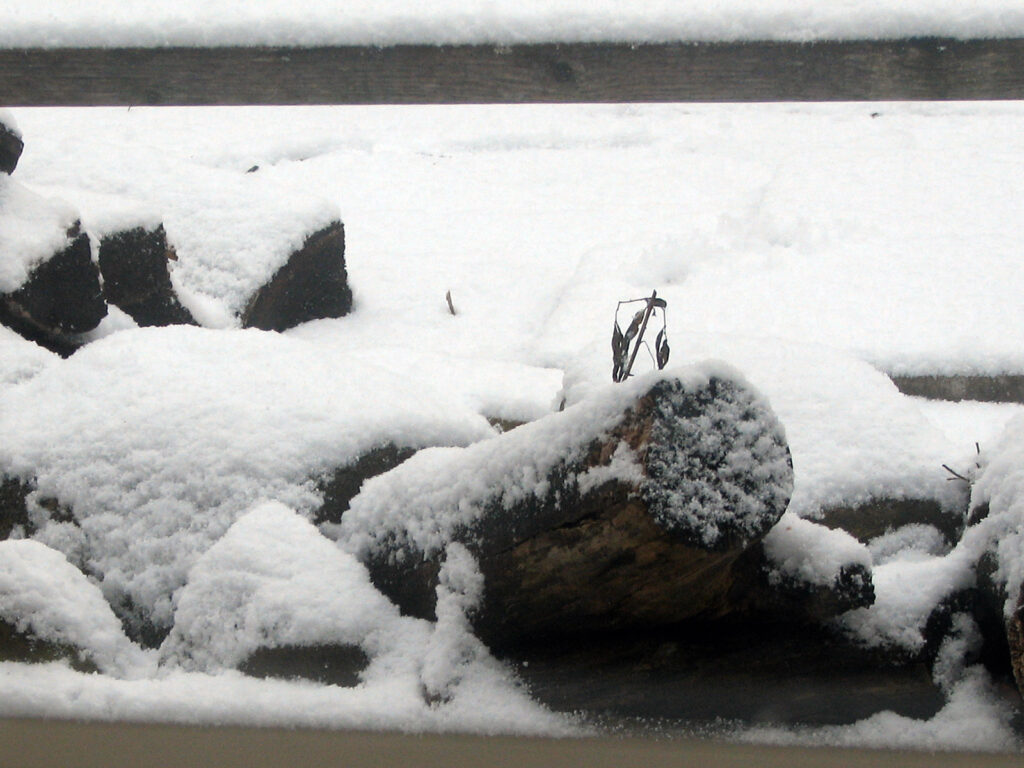
Though we don’t see them in winter, insects are there in our yard. We try to provide the cover they need, which for many kinds of insects also functions as their place to raise young.
Logs and leaf litter are important places for insects to overwinter. We don’t clean up in the fall (except for our small lawn area). Dragonfly larvae overwinter in our ponds.
Amphibians
Amphibians aren’t active in winter either, but they, too, are still in the yard somewhere. Our pond started out as less than 24 inches deep, and as the years go by, it’s increasingly shallower as some degree of muck forms at the bottom. This just doesn’t seem to be deep enough for our green frogs unfortunately. We had a few mild winters soon after we first got frogs, and they survived, but in harsher winters (more typical here in Central NY), they didn’t. We really miss our frogs, and we don’t know how to solve this problem. (We don’t feel guilty about getting them here, though, since they were donated to us by people who found them in their swimming pool and they would have died when they added chlorine.)
Our toads, on the other hand, overwinter in the ground apparently very successfully since we always have toads around. We have lots of bare ground since we have very little lawn, so there are lots of options for them. The biggest danger I worry about is that I’ll spade through them in the spring. We try to be careful, and we don’t start spading in the spring before we have to.
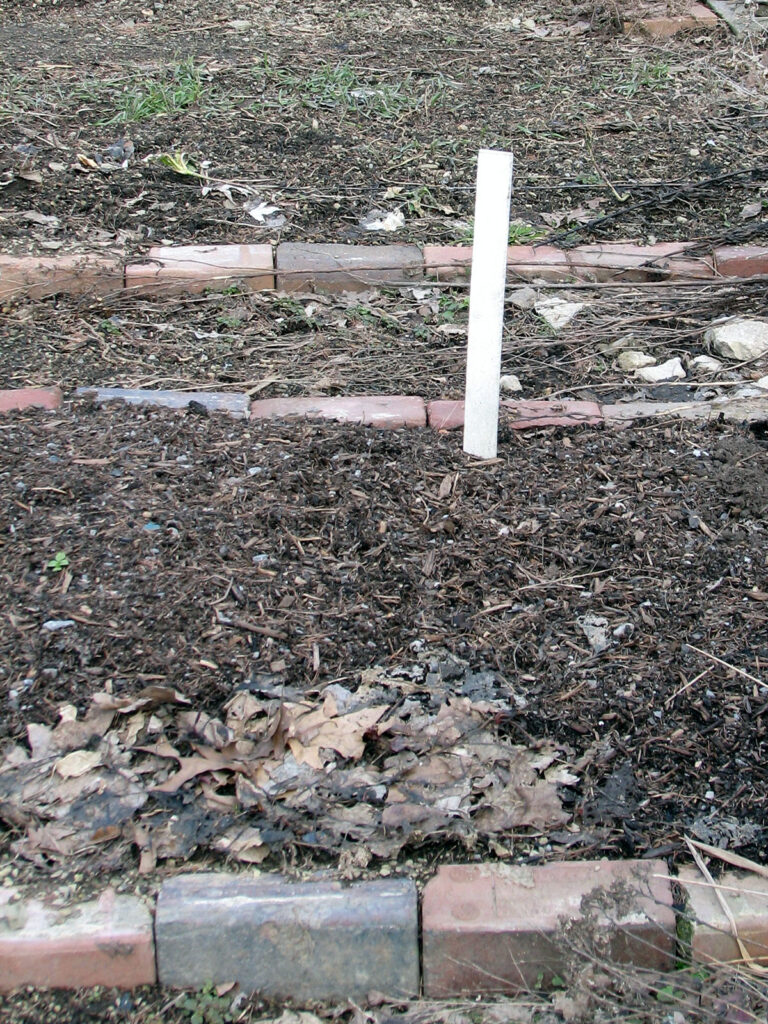
John saw a toad in the garden in the fall and marked where he was so we could check in the spring (and also make sure he didn’t dig there until it was gone).
Mammals
We haven’t really designed our yard for mammals, except for bats (which never showed up). We really enjoy chipmunks, too, but we usually only see them once or twice in winter during a thaw. When I notice them, I throw some peanuts out. Whether we want to or not, we also have squirrels, a few too many, but it could be worse (for example, deer). Squirrels take advantage of our heated birdbath.
Resources
- Nature Conservancy’s Cool Green Science:
- EcoBeneficial:
- Cornell Lab of Ornithology:
- Climate Reality Project:
- Mass Audubon:
- The Humane Gardener:
- Lesley the Bird Nerd:
Reflections
The easiest part of the gardening year, at least for many of us, is winter. There are books on winter gardening, and I politely chose to ignore them altogether. There is little I can or want to do in my freezing garden between November and March. All the same, a good garden should provide shelter for all overwintering insects. A good basic design might interweave the entire garden with dwarf conifers and evergreen shrubs … These plants provide numerous protected places such as twigs and dead leaves on the ground to serve as overwintering sites for all those insects we so desperately want to keep in our gardens. And we especially need to have the predators and parasitoids ready to spring forth to feast on all the plant-feeding insects. The worst possible scenario we gardeners create with our bare-earth policy is that of decoupling the predators and parasitoids from their prey. We don’t want to race into gardening season having to battle the tides of imbalance, there is enough to do already.
~ Eric Grissell, Insects and Gardens: In Pursuit of a Garden Ecology, p. 248
Nature has undoubtedly mastered the art of winter gardening and even the most experienced gardener can learn from the unrestrained beauty around them.
~ Vincent A. Simeone, Wonders of the Winter Landscape
He who marvels at the beauty of the world in summer will find equal cause for wonder and admiration in winter.
~John Burroughs
